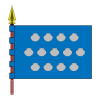A Illa de Arousa
A Illa de Arousa
Isla de Arosa | |
|---|---|
| A Illa de Arousa | |
 Town Hall | |
 Flag  Coat of arms | |
 A Illa de Arousa Location in Spain | |
| Coordinates: 42°33′16″N 8°51′50″W / 42.55444°N 8.86389°WCoordinates: 42°33′16″N 8°51′50″W / 42.55444°N 8.86389°W | |
| Country | |
| Autonomous community | Galicia |
| Province | Pontevedra |
| Comarca | Salnés |
| Government | |
| • Alcalde | Carlos Iglesias Cores (Socialists' Party of Galicia) |
| Area | |
| • Total | 7 km2 (3 sq mi) |
| Elevation | 9 m (30 ft) |
| Population (2018)[1] | |
| • Total | 4,958 |
| • Density | 710/km2 (1,800/sq mi) |
| Demonym(s) | Arousán, á |
| Time zone | UTC+1 (CET) |
| • Summer (DST) | UTC+2 (CEST) |
| Postal code | 36626 |
| Website | http://www.ailladearousa.es/ |
A Illa de Arousa (Spanish: La isla de Arosa) is the only island municipality in Galicia, Spain in the province of Pontevedra. It is located in the heart of the Ria de Arousa. According to 2011 INE the island's population was 5,020 inhabitants. The population is divided into several neighborhoods, and places of interest are the lighthouse's environment, the island of Areoso (close to the Illa de Arousa) and Carreirón Natural Park, which is listed as a special protection zone for heron birds populations among other birds that inhabit the island. The Holy viewpoint is the highest point on the island. "San Xulián da Illa de Arousa" is the only parish in this island. Some of its beaches are the following ones: A Area da Secada, A Lavanqueira, O Vao, Camaxe, Carreirón, Espiñeiro and O Cabodeiro.
A Illa de Arousa has five ports. Xufre is the most important and the other important docks include O Campo, Chazo and Cabodeiro.
Etymology[]
According to , "Arousa", registered as insulam Arauza in 899, would belong to the old European hydronymy, and is derived from the Indoeuropean root *er- 'flow, move'.[2]
See also[]
References[]
- ^ Municipal Register of Spain 2018. National Statistics Institute.
- ^ Cf. pp. 540 y 541 de "La Hidronimia de Galicia: tres estratos ..". http://www.mondonedoferrol.org/estudios-mindonienses/MINDONIENSES%2024%20[protegido].pdf
External links[]
- Concello da Illa de Arousa Townhall of Arousa Island
- Arousa
- A Illa de Arousa - Paraíso Natural en Galicia
| Wikimedia Commons has media related to A Illa de Arousa. |
- Municipalities in the Province of Pontevedra
- Islands of Galicia (Spain)
- Galicia (Spain) geography stubs
